Salvete Amici,
two years ago, in Salve Abusina (Bavaria), we met the blacksmith, trader and gladiator Domi from DKS-Metall. I was struck by his very special secutor helmet in the design of the Kellis vase (see fig. 1).
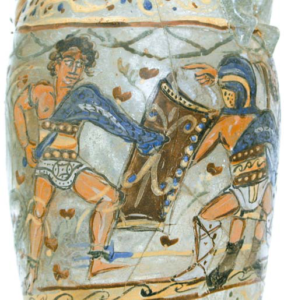
In a relaxed conversation we learned that the helmet was made according to the find from Pompeii and the illustrations from the Junkelmann of this find (Junkelmann, 2008, p. 247). There and on the following page, are some details about the special material of the Secutore’s helmet – it was made of iron and bronze ( visor/crest) (Junkelmann, 2008, p. 248).
In the book „Gladiator Looking on death every day“ one can find even larger and more detailed illustrations (Landesamt für Denkmalpflege und Archäologie Sachsen-Anhalt, 2013, p. 210ff).
Domi’s second consideration in the construction was that in the early imperial period there was an early industrial [1] form of mass production (Bongartz, 2013, p. 100) of helmets to meet the growing needs of the legions. The helmets of the legionaries (at least the imperial Gauls) were already predominantly made of tinned iron at this time (Bongartz, 2013, p. 110). It would presumably not have been a special effort to make a helmet calotte somewhat simpler, for example without stylised eyebrows, and to equip it as a gladiator’s helmet. So he came up with the idea of converting a legionary helmet himself.
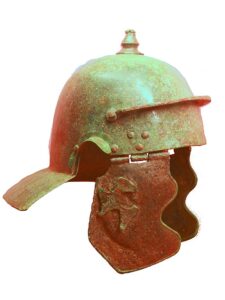
In the third quarter of the 1st century, the helmet type Weisenau (see. fig. 2) was in common use. According to the findings, this helmet type was made of iron and bronze (Wikipedia, 2021). The Museo archeologico Nazionale in Naples has a well-preserved example.
So Domi got a helmet from Battlemerchant [2] and blued it; that means, heated it and rubbed it with olive oil. On the one hand, this gives the helmet its beautiful colouring, and on the other hand, it protects it from moisture. This form of preservation was possible in antiquity, but as far as we know there is no evidence of it.
The visor and the crest of the typical secutore helmet (Gregor Barth, 2019, 23) were attached to the basic body (helmet calotte) of the helmet and thus a gladiator helmet was created with only a few changes to the legionary helmet.
For the visor (see fig. 3) and the crest, a cardboard model was first made, which was transferred to the metal. The form is a freehand form which was adapted to the helmet dimensions and the head. Then the metal was cut to size, shaped and attached to the modified helmet dome. The material used for the visor was 1.5mm brass and the helmet dome was made of 0.8mm steel. For the 30mm eye holes, a 2mm deviation from the original was accepted for manufacturing reasons.
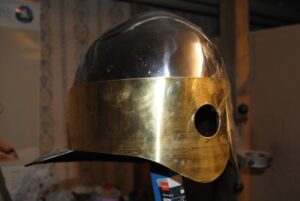
The helmet meets the stability requirements of a gladiator’s helmet and can be worn comfortably. This reconstruction thus shows a credible approach to how gladiator helmets (especially Italo-Celtic helmets) could have been made.
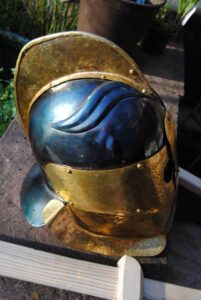
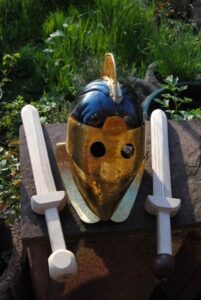
Literaturverzeichnis
Bongartz, A. (2013). Studien zu römischen Helmen: Untersuchungen zu den Funden römischer Infanterie-und Kavalleriehelme vom Ende der Republik bis zum 3. Jahrhundert n. Chr. Dissertation. Köln: Universität zu Köln. Von Universität zu Köln: http://kups.ub.uni-koeln.de/6477/ abgerufen
Gregor Barth, D. R. (2019). Helmübersicht. Von https://www.gladiatorenschule-berlin.rocks/wp-content/uploads/2021/03/ÜbersichtHelmeDE.pdf#page=36 abgerufen
Junkelmann, M. (2008). Gladiatoren: Das Spiel mit dem Tod. Phillip von Zobern.
Landesamt für Denkmalpflege und Archäologie Sachsen-Anhalt. (2013). Gladiator Täglich den Tod vor Augen. Halle: Harald Meller, Valeria Sampaolo, Luigia Melillo.
Wikipedia. (2021). Von Weissenauhelm: https://de.wikipedia.org/wiki/Weisenau_%28Helm%29 abgerufen
[1] Frühindustrielle Fertigungen der Antike sind bereits aus der Keramikherstellung bekannt, in Lezoux, Frankreich wurde eine Keramikwerkstatt mit einem Brennofen gefunden und rekonstruiert, welcher 10- bis 40.000 Stücke fasste http://www.antike-tischkultur.de/keramikbrennofen.html
[2] https://www.battlemerchant.com/roemischer-legionaershelm?c=422